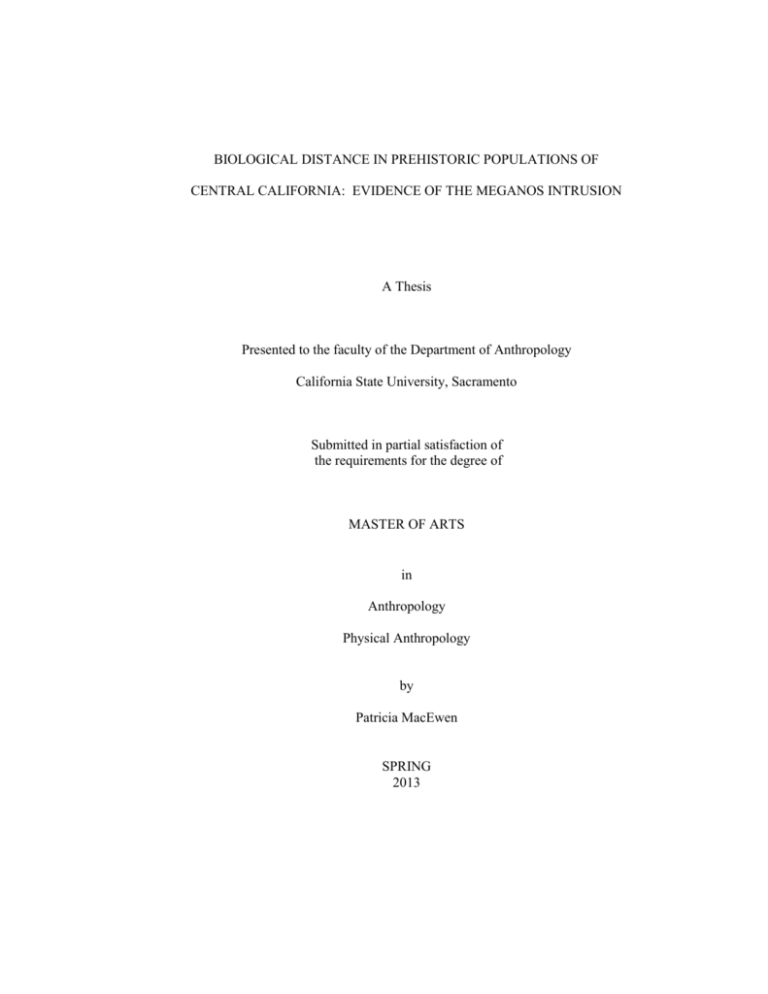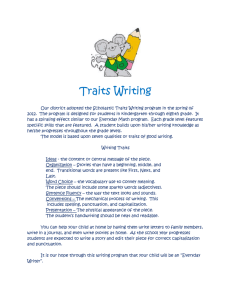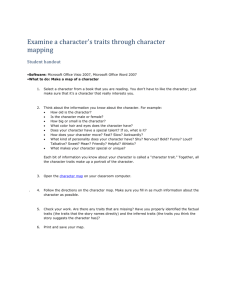
BIOLOGICAL DISTANCE IN PREHISTORIC POPULATIONS OF
CENTRAL CALIFORNIA: EVIDENCE OF THE MEGANOS INTRUSION
A Thesis
Presented to the faculty of the Department of Anthropology
California State University, Sacramento
Submitted in partial satisfaction of
the requirements for the degree of
MASTER OF ARTS
in
Anthropology
Physical Anthropology
by
Patricia MacEwen
SPRING
2013
© 2013
Patricia MacEwen
ALL RIGHTS RESERVED
ii
BIOLOGICAL DISTANCE IN PREHISTORIC POPULATIONS OF
CENTRAL CALIFORNIA: EVIDENCE OF THE MEGANOS INTRUSION
A Thesis
by
Patricia MacEwen
Approved by:
__________________________________, Committee Chair
Dr. Samantha Hens
__________________________________, Second Reader
Dr. M. Elizabeth Strasser
____________________________
Date
iii
Student: Patricia MacEwen
I certify that this student has met the requirements for format contained in the University
format manual, and that this thesis is suitable for shelving in the Library and credit is to
be awarded for the thesis.
__________________________
Dr. Michael Delacorte, Graduate Coordinator
___________________
Date
Department of Anthropology
iv
Abstract
of
BIOLOGICAL DISTANCE IN PREHISTORIC POPULATIONS OF
CENTRAL CALIFORNIA: EVIDENCE OF THE MEGANOS INTRUSION
by
Patricia MacEwen
Population movements in prehistoric California have been difficult to decipher,
none more so than the so-called Meganos Intrusion hypothesized by James Bennyhoff in
1986. This Intrusion described the westward expansion (ca. 500 A.D.) of a Penutianspeaking proto-Miwok group out of California’s San Joaquin Delta into the East Bay and
then southward into the Santa Clara Valley. Lasting perhaps two centuries, the Meganos
Intrusion was itself displaced by another population movement from the north. Returning
to the Delta, the Meganos became the ancestors of the Plains Miwok and/or the closely
related Yokuts. Bennyhoff’s hypothesis was largely based on differences in material
culture, grave goods and burial positions. A difference in physical type noted by several
researchers has never been subjected to osteological analysis. In this study, a metaanalysis of cranial data from six sites associated with or contemporaneous with the
Meganos Intrusion examined both craniometric and discrete traits in order to obtain
estimates of biological distance between these groups. One site, CA-ALA-343, yielded
some burials exhibiting Meganos characteristics and others with non-Meganos
characteristics. This data was divided into test cases according to burial position. The
v
results were compared with data from two contemporary non-Meganos sites in the Santa
Clara Valley (CA-SCL-137 and CA-SCL-674) and three Central Valley sites linked to
groups considered possible ancestors (CA-SJO-091) or possible descendants of the
Meganos (CA-SAC-117 and CA-SJO-105). Craniometric analyses were inconclusive.
Nonmetric trait frequencies, however, show that burials demonstrating Bennyhoff’s
Meganos characteristics at CA-ALA-343 are indeed more closely related to all three
Central Valley sites, while the non-Meganos burials are more closely related to those at
the Santa Clara site, CA-SCL-674. The other Santa Clara site, CA-SCL-137, appears to
be distinct from all of the other groups.
_______________________, Committee Chair
_______________________
Dr. Samantha M. Hens
Date
vi
ACKNOWLEDGMENTS
The author would like to express her gratitude to several people for their assistance and
unending patience. Dr. Samantha Hens allowed me extraordinary leeway in designing
this study and then in getting it completed. Al Schwitalla and Bill Stillman helped me
find and obtain copies of several obscure papers related to this study, as well as site
reports and associated osteological data. Richard E. Thompson, Senior Archeaologist at
Archaeor, kindly allowed me to photocopy reams of data pertaining to the skeletal
remains his company excavated at CA-ALA-343. Dr. Jerald Johnson answered several
very important questions concerning the Central Valley sites he knows so well, and
Kanya Godde provided invaluable assistance in completing the statistical study of
discrete traits in these populations. At her behest, the University of Tennessee very
kindly allowed me the use of software specifically designed for biological distance
studies using binary data, without which this study could not have been completed.
vii
TABLE OF CONTENTS
Page
Acknowledgments...................................................................................................... vii
List of Tables .............................................................................................................. xi
List of Figures ........................................................................................................... xiii
Chapter
1. INTRODUCTION ................................................................................................ 1
2. LITERATURE REVIEW ....................................................................................... 5
Part 1. Archaeological Background ............................................................... 5
Chronology ................................................................................ 6
Population Movements ............................................................. 9
Significance of the Meganos Intrusion ................................... 16
Part 2. Previous Studies of Prehistoric California Cranial Types ................ 19
Part 3. Biological Distance: Metric vs. Nonmetric .................................... 28
Heritability .............................................................................. 30
Similarity and Kinship ........................................................... 33
Environmental Variability ..................................................... 33
Age ......................................................................................... 35
Sex .......................................................................................... 35
Independence ......................................................................... 37
Scoring ................................................................................... 38
Deformation ........................................................................... 38
Unilateral Expression of Bilateral Traits ............................... 39
Fragments ............................................................................... 40
The Great Debate ................................................................... 40
viii
Summary ................................................................................. 42
Part 4.
Research Strategy ........................................................................... 45
3. MATERIALS ....................................................................................................... 48
Part 1. Site Descriptions ............................................................................. 49
CA-SJO-91 .............................................................................. 49
CA-SAC-117 ........................................................................... 49
CA-SJO-105 ............................................................................ 49
CA-ALA-343 .......................................................................... 51
CA-SCL-674 ........................................................................... 52
CA-SCL-137 ........................................................................... 52
Part 2. Data Collection ............................................................................... 53
Definitions ............................................................................... 55
Metric Traits ................................................................... 55
Cranial Measurements ......................................... 55
Mandibular Measurements ................................... 59
Nonmetric Traits ............................................................ 61
Foramina and Canals ............................................ 61
Ossicles ................................................................ 67
Sutures .................................................................. 68
4.
ANALYTICAL METHODS .............................................................................. 69
Part 1. Analysis of Metric Traits ................................................................ 69
Trait Correlation .................................................................... 69
Part 2. Analysis of Nonmetric Traits ......................................................... 73
Trait Elimination ................................................................... 73
Logistic Regression ............................................................... 75
Trait Correlation .................................................................... 79
Sex Correlation ..................................................................... 81
Tetrachoric Correlation Matrix ............................................. 82
ix
Principal Components Analysis ............................................ 85
5. RESULTS ............................................................................................................ 87
Part 1. Results for Metric Traits ................................................................. 87
Part 2. Results for Nonmetric Traits .......................................................... 93
Outcome of Principal Components Analysis ....................... 98
6. CONCLUSIONS ................................................................................................ 105
Part 1.
Evidence of the Meganos Intrusion ............................................. 105
From Craniometric Traits ................................................. 106
From Nonmetric Traits ..................................................... 108
Part 2.
Metric vs. Nonmetric Analytical Techniques .............................. 111
Appendix 1
Craniometric Data ............................................................................ 113
Appendix 2.
Mandibular Data................................................................................ 125
Appendix 3.
Nonmetric Data ................................................................................. 120
References ................................................................................................................ 132
x
LIST OF TABLES
Page
1.
Chronology for the Prehistoric San Francisco Bay Area ........................................7
2.
Sample Sites/Components Used in This Study .....................................................45
3.
Raw Data Sample Sizes ........................................................................................53
4.
Binary Datapoints for CA-SCL-137 After Logistic Regression ...........................78
5.
Binary Datapoints for CA-ALA-343e After Logistic Regression ........................78
6.
Pearson’s Correlation Cofficient (R) for 5 Traits .................................................80
7.
Student’s t-Test, Two-tailed (p-values) ................................................................80
8.
Pearson’s Correlation Coefficient (R) for 3 Traits ...............................................82
9.
Final Nonmetric Sample Sizes ..............................................................................82
10.
ANOVA results for Minimum Frontal Breadth ....................................................87
11.
ANOVA results for Minimum Ramus Breadth ....................................................88
12.
ANOVA results for Maximum Ramus Height .....................................................88
13.
Two-Tailed P Values for Minimum Frontal Breadth ...........................................91
14.
Two-Tailed P Values for Minimum Ramus Breadth ............................................92
15.
Two-Tailed P Values for Maximum Ramus Height .............................................92
16.
Tetrachoric Correlation Matrix .............................................................................94
17.
Eigenvectors for Threshold Traits in Each Test Case ...........................................94
18.
D2 Matrix of Mahalanobis Distances for Nonmetric Traits ..................................95
19.
Mahalanobis Distances in Order of Decreasing Similarity ...................................96
xi
20.
Eigenvalues for Principal Components .................................................................99
21.
Cumulative Importance of Principal Components ................................................99
xii
LIST OF FIGURES
Page
1.
Linguistic Families of the California Culture Province ........................................11
2.
Windmiller Pattern (Meganos) Artifacts from CA-ALA-343 (Hylkema 2002) ....13
3.
Typical Berkeley Pattern Artifacts (Hylkema 2002) ............................................13
4.
Typical Windmiller burial position (after Moratto 1984:120) ...............................14
5.
Typical flexed burial position (from Grady, Latham & Andruschko 1999:124) ..15
6.
The Meganos intrusion into the San Francisco Bay Area (maps redrawn from
Bennyhoff and Fredrickson 1994) ........................................................................17
7.
Location of archaeological sites to be used in current study ................................50
8.
Cranial measurements in the sagittal plane ...........................................................56
9.
Cranial measurements, frontal view .....................................................................57
10.
Cranial measurements, frontal view .....................................................................58
11.
Measurements of the mandible, anterior view ......................................................60
12 .
Measurements of the mandible, lateral view ........................................................60
13.
Frontal view of cranial vault showing locations of metopic suture, supraorbital
foramina, infraorbital foramina, and zygomatico-facial foramina ........................62
14.
Superior and lateral aspect of cranial vault showing locations of parietal
foramina, sutural bones and mastoid foramen ......................................................63
15.
Posterior and basilar aspects of the cranial vault, showing the locations of the
condylar canal and lesser accessory palatine foramina .........................................64
16.
Ranges and Means, Minimum Frontal Breadth (in mm.) for all sites ..................89
xiii
17.
Ranges and Means, Minimum Ramus Breadth (in mm.) for all sites ...................89
18.
Ranges and Means, Maximum Ramus Height (in mm.) for all sites ....................90
19.
Scree Chart of Principal Components .................................................................100
20.
Eigenvectors – Principal Component 1 ...............................................................101
21.
Eigenvectors – Principal Componenet 4 .............................................................102
22.
Principal Components 1 and 4 ............................................................................103
xiv











